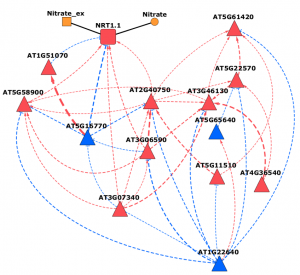In-silico Model Integration of Nitrogen Transporter, NRT1.1 with Nitrogen Responsive Transcription Factor Network

Current forecasts predict a discrepancy between supply and demand of staple crops within 50 years. There is a need to accelerate breeding programs to generate more efficient crops to meet this challenge. One approach is computer assisted breeding that models plant response to hundreds of in silico perturbations. Nitrogen is an essential nutrient for plant growth and an important signaling molecule. It is transported into the plant as nitrate via the nitrate transporter NRT1.1. While existing models describe regulatory mechanisms controlling N-uptake and assimilation, they are inadequate to predict emergent system response to N-signal. Here, I describe a multiscale model that integrates Molecular Dynamics Simulation (MDS) and Gene Regulatory Network (GRN) analysis into an Agent-Based Model (ABM). The aggregate model is anticipated to do a better job simulating whole plant response to N-signal than independent models. The MDS of NRT1.1 simulates protein structural states in response to nitrate signal and to phosphorylation. The dynamic GRN predicts the level of influence of transcription factors (TFs) on the expression of NRT1.1. An existing GRN was modified to include only TFs predicted to directly influence NRT1.1 expression. Models were translated into the Systems Biology Markup Language to facilitate integration into the ABM using the FLAME software. Here, extracellular nitrate concentration and changes in NRT1.1 transcript levels are inputs for the molecular model resulting in changes to the protein state. Change in nitrate uptake rate and total cellular nitrate concentration are inputs to the cellular model. These agents communicate via “message boards” that iteratively change the state of each model in response to a new signal. The integrated model serves as a novel tool to study the dynamic cellular response and emergent behavior of plants to a N-signal, and thus has the potential to direct breeding of more N-efficient crops.
Stuti Shrivastava, In-silico Model Integration of Nitrogen Transporter, NRT1.1 with Nitrogen Responsive Transcription Factor Network. Poster presented at the Plant Biology 2016 Meeting. July 9 -13, 2016. Austin, TX.

